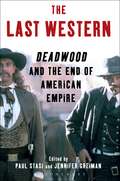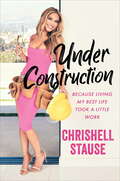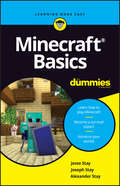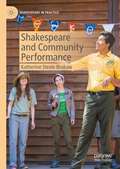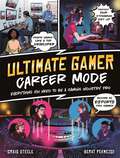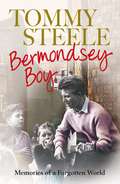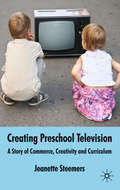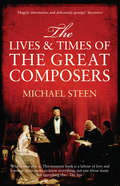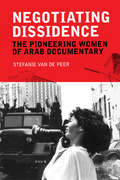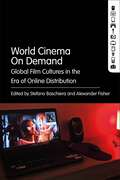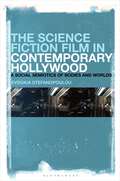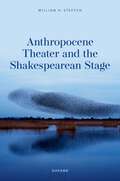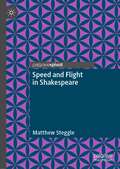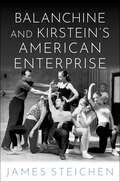- Table View
- List View
The Last Western: Deadwood and the End of American Empire
by Paul Stasi Jennifer GreimanPerhaps the most sophisticated and complex of shows in HBO's recent history, Deadwood has surprisingly little coverage in our current scholarship. Grounding contemporary anxieties about race and class, domesticity and American exceptionalism in its nineteenth-century setting, Deadwood revises our understanding of a formative period for the American nation through a re-examination of one of the main genres through which this national story has been transmitted: the Western. With contributions from scholars in American studies, literature, and film and television studies, The Last Western situates Deadwood in the context of both its nineteenth-century setting and its twenty-first-century audience. Together, these essays argue for the series as a provocative meditation on both the state and historical formation of U.S. empire, examining its treatment of sovereign power and political legitimacy, capital accumulation and dispossession, racial and gender identities, and social and family structures, while attending to the series' peculiar and evocative aesthetic forms. What emerges from this collection is the impressive range of Deadwood's often contradictory engagement with both nineteenth and twenty-first century America.
Under Construction: Because Living My Best Life Took a Little Work
by Chrishell StauseA heartfelt, humorous personal memoir and relatable guide to overcoming obstacles, wising up about romance, and getting ahead in your career from the star of Netflix's hit reality show Selling Sunset.In this engaging, witty, and inspirational memoir, Chrishell Stause shares her story of living an unconventional childhood in small-town Kentucky marked by periods of homelessness, family addiction struggles and dreams of one day being on a daytime soap, all while managing the local Dairy Queen. Through resilience and grit, she overcame obstacles and pushed past every barrier in her path to become one of the most envied luxury realtors in Los Angeles and buzzworthy cast members in reality TV.She takes us behind the scenes of Selling Sunset, reveals never-before-told stories from her life in soaps, and even pulls back the curtain on her highly publicised love life, offering insight not before shared. With her signature honesty and charm, Stause also gives tangible advice based on the lessons she's learned over the years and offers unique insight about how to stay resilient and positive no matter how many times life knocks you down. Under Construction is for anyone who wants to remember that no matter what happens or how, you have to get up, dress up and show up - and walk back into the room stronger than ever before.
Minecraft Basics For Dummies
by Jesse Stay Joseph Stay Alex StayThe easy way to get started with Minecraft Want to creep into the biggest video game of all time? Grab your pickaxe and let's go! Minecraft Basics For Dummies helps you (or your kids) get started and join the infinite online world that keeps millions of players of all ages engaged every day. Inside this portable-trim book, crafters will get all the tips and tricks needed to get started—on their own or with multiple players—in each of the three gameplay modes. Choose a platform and download the game Navigate, collect resources, and build structures Defend your creations against monsters Manage parental controls to keep kids safe while playing online Become a Minecraft master by defeating the Ender Dragon Unleash your creativity, elevate family game night, and have a ton of fun joining more than 141 million players in the online world of Minecraft!
Minecraft Basics For Dummies
by Jesse Stay Joseph Stay Alex StayThe easy way to get started with Minecraft Want to creep into the biggest video game of all time? Grab your pickaxe and let's go! Minecraft Basics For Dummies helps you (or your kids) get started and join the infinite online world that keeps millions of players of all ages engaged every day. Inside this portable-trim book, crafters will get all the tips and tricks needed to get started—on their own or with multiple players—in each of the three gameplay modes. Choose a platform and download the game Navigate, collect resources, and build structures Defend your creations against monsters Manage parental controls to keep kids safe while playing online Become a Minecraft master by defeating the Ender Dragon Unleash your creativity, elevate family game night, and have a ton of fun joining more than 141 million players in the online world of Minecraft!
Reframing Vivien Leigh: Stardom, Gender, and the Archive
by Lisa SteadReframing Vivien Leigh takes a new look at the laboring life one of the twentieth century's most iconic stars. Author Lisa Stead reframes the dominant narratives that have surrounded Leigh's life and career, offering a new perspective on Vivien Leigh as a distinctly archival subject. The book examines the collections and curatorial practices that have built up around her, exploring material documents collated by her own hand and by those who worked with her. The book also examines the collection practices of those who have developed deep, long-standing fandoms of her life and work. To do so, the book draws upon new oral history work with curators, archivists and fan collectives and examines a variety of archived correspondence, items of dress and costume, script annotations, photography, press clippings, props and memorabilia. It argues that such material has the potential to produce a new interpretation of Leigh as a creative laborer. As such, the book casts new light on the labor of archiving itself and the significance of archival processes and practices to contemporary feminist film historiography.
Reframing Vivien Leigh: Stardom, Gender, and the Archive
by Lisa SteadReframing Vivien Leigh takes a new look at the laboring life one of the twentieth century's most iconic stars. Author Lisa Stead reframes the dominant narratives that have surrounded Leigh's life and career, offering a new perspective on Vivien Leigh as a distinctly archival subject. The book examines the collections and curatorial practices that have built up around her, exploring material documents collated by her own hand and by those who worked with her. The book also examines the collection practices of those who have developed deep, long-standing fandoms of her life and work. To do so, the book draws upon new oral history work with curators, archivists and fan collectives and examines a variety of archived correspondence, items of dress and costume, script annotations, photography, press clippings, props and memorabilia. It argues that such material has the potential to produce a new interpretation of Leigh as a creative laborer. As such, the book casts new light on the labor of archiving itself and the significance of archival processes and practices to contemporary feminist film historiography.
Shakespeare and Community Performance (Shakespeare in Practice)
by Katherine Steele BrokawThis book explores how productions of Shakespearean plays create meaning in specific communities, with special attention to issues of access, adaptation, and activism. Instead of focusing on large professional companies, it analyzes performances put on by community theatres and grassroots companies, and in applied drama projects. It looks at Shakespearean productions created by marginalized populations in Greater London, Harlem, and Los Angeles, a Hamlet staged in the remote Faroe Islands, and eco-theatre made in California’s Yosemite National Park. The book investigates why different communities perform Shakespeare, and what challenges, opportunities, and triumphs accompany the processes of theatrical production for both the artists and the communities in which they are embedded.
Ultimate Gamer: Everything You Need To Be A Gaming Industry Pro
by Craig SteeleTake your gaming skills beyond the screen in Ultimate Gamer: Career Mode – the ultimate handbook to becoming a top game developer, Twitch streamer or the next eSports pro! Written by Craig Steele – who has led gaming workshops at Resonate and Insomnia – and illustrated by Berat Pekmezci, this book will give you the low-down on the coolest jobs in the gaming industry.Learn how to storyboard, code and test games, just like your favourite devs, or boost your Twitch subs by learning how to go pro. Think you have the skills to compete in eSports tournaments, or do you need some tips on getting good? This book will give you the know-how on making it big in all areas of the gaming industry!
Bermondsey Boy: Memories of a Forgotten World
by Tommy SteeleThirties Bermondsey was a thriving place, and it was in this bustling London borough that Thomas Hicks was born. Later, this Bermondsey boy would become known as Tommy Steele …In this engaging memoir Tommy recalls his childhood years growing up in Bermondsey. He relives with great fondness Saturdays as a young boy, spent gazing at the colourful posters for the Palladium and days spent wandering up Tower Bridge Road to Joyce’s Pie Shop for pie and mash. But he also brings to life with extraordinary vividness what it was like to live through the devastation of the Blitz.Yet it was once he joined the merchant navy and began singing and performing for his fellow seamen that his natural ability as an entertainer marked him out as a favourite. And it was while ashore in America that he became hooked on rock’n’roll and a legend was born …From Tommy’s humble beginning to life at sea and finally as a performer, Bermondsey Boy is a colourful, charming and deeply engaging memoir from a much-loved entertainer.
Creating Preschool Television: A Story of Commerce, Creativity and Curriculum
by J. SteemersSmall children are regularly captivated by programmes made especially for them – ranging from classics like Sesame Street to more recent arrivals such as Blues Clues and Teletubbies . This book examines the industry interests behind preschool television, and how commercial, creative and curricular priorities shape and inform what is produced.
The Lives and Times of the Great Composers: The Great Composers (The\great Composers Ser.)
by Michael Steen'A glorious plum-pudding of a book, to be consulted, with pleasure and profit, over and over again' Sir Jeremy Isaacs Michael Steen's 'Great Composers' was originally published in 2003. A lifetime's work and almost 1000 pages long, it has since become 'the' reference point and key read on the biographical backgrounds to classical music's biggest names. Authoritative and hugely detailed - but nonetheless a joy to read - this new edition will expand its readership further and capitalise on a newfound popular interest in classical music. Steen's book helps you explore the story of Bach, the respectable burgher much of whose vast output was composed amidst petty turf disputes in Lutheran Leipzig; or the ugly, argumentative Beethoven in French-occupied Vienna, obsessed by his laundry; or Mozart, the over-exploited infant prodigy whose untimely death was shrouded in rumour. Read about Verdi, who composed against the background of the Italian Risorgimento; or about the family life of the Wagners; and, Brahms, who rose from the slums of Hamburg to become a devotee of beer and coffee in fin-de-siecle Vienna, a cultural capital bent on destroying Mahler...and much, much more.
Negotiating Dissidence: The Pioneering Women of Arab Documentary
by Stefanie Van de PeerIn spite of harsh censorship, conservative morals and a lack of investment, women documentarists in the Arab world have found ways to subtly negotiate dissidence in their films, something that is becoming more apparent since the ‘Arab Revolutions’. In this book, Stefanie Van de Peer traces the very beginnings of Arab women making documentaries in the Middle East and North Africa (MENA), from the 1970s and 1980s in Egypt and Lebanon, to the 1990s and 2000s in Morocco and Syria. Supporting a historical overview of the documentary form in the Arab world with a series of in-depth case studies, Van de Peer looks at the work of pioneering figures like Ateyyat El Abnoudy, the ‘mother of Egyptian documentary’, Tunisia’s Selma Baccar and the Palestinian filmmaker Mai Masri. Addressing the context of the films’ production, distribution and exhibition, the book also asks why these women held on to the ideals of a type of filmmaking that was unlikely to be accepted by the censor, and looks at precisely how the women documentarists managed to frame expressions of dissent with the tools available to the documentary maker.
Negotiating Dissidence: The Pioneering Women of Arab Documentary (Edinburgh University Press)
by Stefanie Van de PeerIn spite of harsh censorship, conservative morals and a lack of investment, women documentarists in the Arab world have found ways to subtly negotiate dissidence in their films, something that is becoming more apparent since the ‘Arab Revolutions’. In this book, Stefanie Van de Peer traces the very beginnings of Arab women making documentaries in the Middle East and North Africa (MENA), from the 1970s and 1980s in Egypt and Lebanon, to the 1990s and 2000s in Morocco and Syria. Supporting a historical overview of the documentary form in the Arab world with a series of in-depth case studies, Van de Peer looks at the work of pioneering figures like Ateyyat El Abnoudy, the ‘mother of Egyptian documentary’, Tunisia’s Selma Baccar and the Palestinian filmmaker Mai Masri. Addressing the context of the films’ production, distribution and exhibition, the book also asks why these women held on to the ideals of a type of filmmaking that was unlikely to be accepted by the censor, and looks at precisely how the women documentarists managed to frame expressions of dissent with the tools available to the documentary maker.
World Cinema On Demand: Global Film Cultures in the Era of Online Distribution
by Stefano Baschiera and Alexander FisherWorld Cinema on Demand brings together diverse contributions by leading film and media scholars to examine world cinema's dialogue with the transformations that took place during 2010-2014, engaging directly with ongoing debates surrounding national cinema, transnational identity, and cultural globalization, as well as ideas about genre, fandom and cinephilia. The contributions look at individual national patterns of online distribution, engaging with archives, SVODS and torrent communities. The essays also investigate the cross-cultural presence of world cinema in non-domestic online markets (such as Europe's, for example). As a result, the volume sheds light on geo-politically specific issues of film circulation, consumption and preservation within a range of culturally diverse filmmaking contexts, including case studies from India, Nigeria, Mexico and China. In this way, the collection maps the impact of different online formats of distribution in the understanding of World Cinema, underlining the links between distribution and media provisions as well as engaging with new forms of intermediation.
The Science Fiction Film in Contemporary Hollywood: A Social Semiotics of Bodies and Worlds
by Evdokia StefanopoulouThe Science Fiction Film in Contemporary Hollywood focuses on the American science fiction (SF) film during the period 2001-2020, in order to provide a theoretical mapping of the genre in the context of Conglomerate Hollywood. Using a social semiotics approach in a systematic corpus of films, the book argues that the SF film can be delineated by two semiotic squares -the first one centering on the genre's more-than-human ontologies (SF bodies), and the second one focusing on its imaginative worlds (SF worlds). Based on this theoretical framework, the book examines the genre in six cycles, which are placed in their historical context, and are analyzed in relation to cultural discourses, such as technological embodiment, race, animal-human relations, environmentalism, global capitalism, and the techno-scientific Empire. By considering these cycles -which include superhero films, creature films, space operas, among others-as expressions of the genre's basic oppositions, the book facilitates the comparison and juxtaposition of films that have rarely been discussed in tandem, offering a new perspective on the multiple articulations of the SF film in the new millennium.
The Science Fiction Film in Contemporary Hollywood: A Social Semiotics of Bodies and Worlds
by Evdokia StefanopoulouThe Science Fiction Film in Contemporary Hollywood focuses on the American science fiction (SF) film during the period 2001-2020, in order to provide a theoretical mapping of the genre in the context of Conglomerate Hollywood. Using a social semiotics approach in a systematic corpus of films, the book argues that the SF film can be delineated by two semiotic squares -the first one centering on the genre's more-than-human ontologies (SF bodies), and the second one focusing on its imaginative worlds (SF worlds). Based on this theoretical framework, the book examines the genre in six cycles, which are placed in their historical context, and are analyzed in relation to cultural discourses, such as technological embodiment, race, animal-human relations, environmentalism, global capitalism, and the techno-scientific Empire. By considering these cycles -which include superhero films, creature films, space operas, among others-as expressions of the genre's basic oppositions, the book facilitates the comparison and juxtaposition of films that have rarely been discussed in tandem, offering a new perspective on the multiple articulations of the SF film in the new millennium.
Contemp Bugarian Theatre 2
by StefanovaFirst Published in 1998. Routledge is an imprint of Taylor & Francis, an informa company.
Contemp Bugarian Theatre 2
by StefanovaFirst Published in 1998. Routledge is an imprint of Taylor & Francis, an informa company.
Anthropocene Theater and the Shakespearean Stage
by William H. SteffenAnthropocene Theater and the Shakespearean Stage revises the anthropocentric narrative of early globalization from the perspective of the non-human world in order to demonstrate Nature's agency in determining ecological, economic, and colonial outcomes. It welcomes readers to reimagine theater history in broader terms, and to account for more non-human and atmospheric players in the otherwise anthropocentric history of Shakespearean performance. This book analyses plays, horticultural manuals, cosmetic recipes, Puritan polemics, and travel writing in order to demonstrate how the material practices of the stage both catalyze and resist early forms of globalization in an ecological arena. William Steffen addresses the role of an understudied ecological performance history in determining Shakespeare's iconic cultural status, and models how non-human players have undermined Shakespeare's authoritative role in colonial discourse. Finally, this book makes a celebratory argument for the humanities in the age of climate change, and invites interdisciplinary engagement a research community that is compelled to find strategies for cultivating a hopeful tomorrow amidst unprecedented anthropogenic environmental changes.
Anthropocene Theater and the Shakespearean Stage
by William H. SteffenAnthropocene Theater and the Shakespearean Stage revises the anthropocentric narrative of early globalization from the perspective of the non-human world in order to demonstrate Nature's agency in determining ecological, economic, and colonial outcomes. It welcomes readers to reimagine theater history in broader terms, and to account for more non-human and atmospheric players in the otherwise anthropocentric history of Shakespearean performance. This book analyses plays, horticultural manuals, cosmetic recipes, Puritan polemics, and travel writing in order to demonstrate how the material practices of the stage both catalyze and resist early forms of globalization in an ecological arena. William Steffen addresses the role of an understudied ecological performance history in determining Shakespeare's iconic cultural status, and models how non-human players have undermined Shakespeare's authoritative role in colonial discourse. Finally, this book makes a celebratory argument for the humanities in the age of climate change, and invites interdisciplinary engagement a research community that is compelled to find strategies for cultivating a hopeful tomorrow amidst unprecedented anthropogenic environmental changes.
Speed and Flight in Shakespeare
by Matthew SteggleShakespeare's plays are fascinated by the problems of speed and flight. They are repeatedly interested in humans, spirits, and objects that move very fast; become airborne; and in some cases even travel into space. In Speed and Flight in Shakespeare, the first study of any kind on the subject, Steggle looks at how Shakespeare’s language explores ideas of speed and flight, and what theatrical resources his plays use to represent these states. Shakespeare has, this book argues, an aesthetic of speed and flight. Featuring chapters on The Comedy of Errors, A Midsummer Night’s Dream, Romeo and Juliet, Henry V, Macbeth and The Tempest, this study opens up a new field around the ‘historical phenomenology’ of early modern speed.
Balanchine and Kirstein's American Enterprise
by James SteichenIn 1933 choreographer George Balanchine and impresario Lincoln Kirstein embarked on an elusive quest to found a ballet company and school in the United States. Though their efforts would eventually result in the creation of the New York City Ballet and the School of American Ballet, the first decade of their collaborative efforts was anything but assured. Tracing the tangled histories of two of the most important figures in twentieth-century dance, Balanchine and Kirstein's American Enterprise offers a fresh perspective on a pivotal period in cultural history. Deeply researched using sources only made available in recent years, the book challenges the mythologies surrounding the early years of the Balanchine-Kirstein enterprise. It also reveals the full extent of Kirstein's essential role and offers reconstructive analysis of lost works, as well as new and surprising details regarding some of Balanchine's most iconic ballets, including Serenade, Apollo, and Concerto Barocco. This history involved artists including Richard Rodgers, Martha Graham, George Gershwin, Katherine Dunham, Vera Zorina, and Igor Stravinsky, as well as dozens of lesser known players whose contributions have yet to be fully acknowledged. Capturing the full sweep of Balanchine and Kirstein's collaborative work across multiple genres and institutions, this book reveals their partnership in all of its exciting and ungainly complexity, showing how the 1930s Balanchine was not the artist that he would eventually become, and how the same was true of the institutions that he and Kirstein jointly created.
Balanchine and Kirstein's American Enterprise
by James SteichenIn 1933 choreographer George Balanchine and impresario Lincoln Kirstein embarked on an elusive quest to found a ballet company and school in the United States. Though their efforts would eventually result in the creation of the New York City Ballet and the School of American Ballet, the first decade of their collaborative efforts was anything but assured. Tracing the tangled histories of two of the most important figures in twentieth-century dance, Balanchine and Kirstein's American Enterprise offers a fresh perspective on a pivotal period in cultural history. Deeply researched using sources only made available in recent years, the book challenges the mythologies surrounding the early years of the Balanchine-Kirstein enterprise. It also reveals the full extent of Kirstein's essential role and offers reconstructive analysis of lost works, as well as new and surprising details regarding some of Balanchine's most iconic ballets, including Serenade, Apollo, and Concerto Barocco. This history involved artists including Richard Rodgers, Martha Graham, George Gershwin, Katherine Dunham, Vera Zorina, and Igor Stravinsky, as well as dozens of lesser known players whose contributions have yet to be fully acknowledged. Capturing the full sweep of Balanchine and Kirstein's collaborative work across multiple genres and institutions, this book reveals their partnership in all of its exciting and ungainly complexity, showing how the 1930s Balanchine was not the artist that he would eventually become, and how the same was true of the institutions that he and Kirstein jointly created.
The Face on Film
by Noa SteimatskyThe human face was said to be rediscovered with the advent of motion pictures, in which it is often viewed as expressive locus, as figure, and even as essence of the cinema. But how has the modern, technological, mass-circulating art revealed the face in ways that are also distinct from any other medium? How has it altered our perception of this quintessential incarnation of the person? The archaic powers of masks and icons, the fashioning of the individual in the humanist portrait, the modernist anxieties of fragmentation and de-figuration--these are among the cultural precedents informing our experience in the movie theatre. Yet the moving image also offers radical new confrontations with the face: Dreyer's Passion of Joan of Arc, Donen's Funny Face, Hitchcock's The Wrong Man, Bresson's enigmatic Au hasard Balthazar, Antonioni's Screen Test, Warhol's filmic portraits of celebrity and anonymity are among the key works explored in this book. In different ways these intense encounters manifest a desire for transparency and plenitude, but--especially in post-classical cinema--they also betray a profound ambiguity that haunts the human countenance as it wavers between image and language, between what we see and what we know. The spectacular impact of the cinematic face is uncannily bound up with an opacity, a reticence. But is it not for this very reason that, like faces in the world, it still enthralls us?
The Face on Film
by Noa SteimatskyThe human face was said to be rediscovered with the advent of motion pictures, in which it is often viewed as expressive locus, as figure, and even as essence of the cinema. But how has the modern, technological, mass-circulating art revealed the face in ways that are also distinct from any other medium? How has it altered our perception of this quintessential incarnation of the person? The archaic powers of masks and icons, the fashioning of the individual in the humanist portrait, the modernist anxieties of fragmentation and de-figuration--these are among the cultural precedents informing our experience in the movie theatre. Yet the moving image also offers radical new confrontations with the face: Dreyer's Passion of Joan of Arc, Donen's Funny Face, Hitchcock's The Wrong Man, Bresson's enigmatic Au hasard Balthazar, Antonioni's Screen Test, Warhol's filmic portraits of celebrity and anonymity are among the key works explored in this book. In different ways these intense encounters manifest a desire for transparency and plenitude, but--especially in post-classical cinema--they also betray a profound ambiguity that haunts the human countenance as it wavers between image and language, between what we see and what we know. The spectacular impact of the cinematic face is uncannily bound up with an opacity, a reticence. But is it not for this very reason that, like faces in the world, it still enthralls us?
